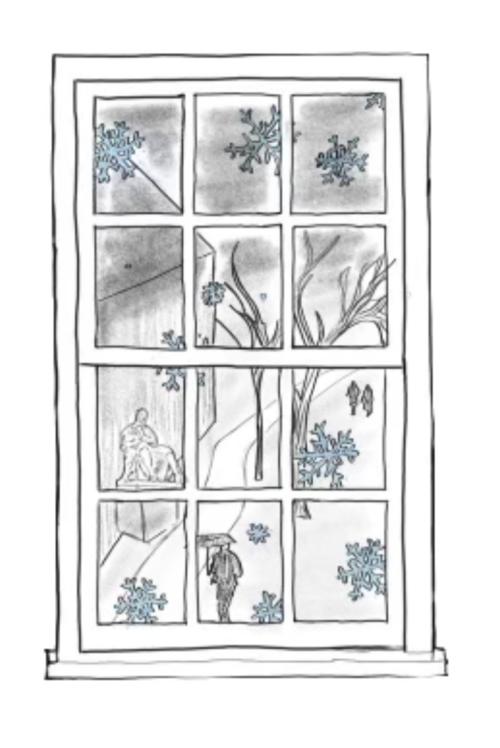Feeling unmotivated? Having trouble finishing your work? Experiencing difficulty getting out of bed or making plans with friends? Not able to enjoy reading Indy articles the way you did in the fall? You’re not alone.
It’s that time of year again. Hands-too-frozen-to-send-a-text, leggings-under-jeans, gets-dark-before-class-ends time. Winter has descended upon Boston, and the weather has plunged below freezing, prompting students to break out their scarves, hats, and gloves. Although the winter months are generally challenging for everyone, students coming back from break may be particularly unsettled by the abrupt shift in weather, and Harvard does very little to help.
While returning to the warmth of your dorm should offer immediate relief from the chilling outdoor temperatures, the dorms in the Yard are not always so comforting. Upon their return to campus, students received an email from Yard Operations explaining that they were experiencing “issues with the hot water in the Yard.” Many first-years took cold showers during their first week back, extending their exposure to the chilly outdoors.
Students from warmer areas may have a hard time adjusting to Boston’s brutal winter conditions. One such student reported feeling “on the downside.” They explained “not only is the cold uncomfortable to be around in, but the period during which the sun set so early, like 4:30, was slightly depressing. I am used to living in the warm south with plenty of sunlight to help my mood, so it was a surprise to experience this type of northeast winter.”
Even students used to the cold weather have trouble adapting to winter on campus. “It feels like between every class I come back to my bed and get back in and just want to fall asleep for the rest of the day,” said one anonymous first-year student. While some exhaustion and lack of motivation can be common for hardworking students in the throes of the semester, abrupt changes in energy levels or disposition during the winter months are often indicators of seasonal mood changes or, in extreme cases, a more clinical phenomenon.
Seasonal Affective Disorder (SAD) is a mood disorder that affects an estimated 6% of the United States population. With the shifting seasons, your body naturally reacts to alterations in sunlight patterns. However, individuals experiencing SAD struggle to adapt to these changes, particularly when coping with the reduced sunlight during the winter months.
While symptoms vary depending on the person, patients may experience a loss of interest in activities, social withdrawal, hopelessness, fatigue, irritability, anxiety, or difficulty concentrating. Though SAD has no definitive diathesis, according to Johns Hopkins Medicine, it could be that “shorter days and less daylight may trigger a chemical change in the brain leading to symptoms of depression.” In other words, the winter climate may prompt an alteration in brain circuitry which mimics a depressive episode.
Other factors may be at play for those experiencing SAD. Increased levels of stress and light deprivation are associated with an increased risk for the onset of SAD. As many students know, there is nothing worse than leaving the Science Center after a long lecture and seeing that the sun has gone down. Here in Boston, it gets dark at around 4:30 P.M., with the sun setting around 5:00 P.M.. With limited hours of sunlight, the light of day can feel incredibly short while the outrageously cold walks between classes seem to drag on for ages.
Given Boston’s abysmal winter climate and SAD’s reasonably high prevalence rate, it would be reasonable to assume Harvard offers readily available resources for navigating seasonal mood changes. But, in fact, SAD is notably missing from the list of specialties of Harvard’s Counseling and Mental Health Services (CAMHS) team. A patient presenting with a diagnosis or symptoms of SAD may well be properly treated by CAMHS clinicians, but unlike the thirty other specialties featured on the CAMHS website, students cannot find a clinician listed that specializes in treating this diagnosis.
This seeming lack of support for students with SAD on a clinical level, in addition to maintenance issues, such as the Yard’s cold showers, means Harvard has a long way to go in terms of better acknowledging and accommodating the psychological harm that winter brings. That being said, hope is not lost for students suffering from the changing seasons.
If you’re experiencing the winter blues, consider maintaining a regular exercise routine or partnering up with friends for workouts to stay motivated. Aim to wake up in the morning when it is light outside and open your blinds to invite natural sunlight into your room. Keep your dorm comfortable by acquiring additional blankets or using space heaters. And lean into all that the winter has to offer! Whether it’s cozy cold-day outfits, movie nights and hot chocolate with friends, ice skating in Boston, or even comping the Independent, finding a silver lining to the gray winter clouds will make the next few months much more bearable.
If you are experiencing more severe depressive symptoms in sync with the onset of winter, there are resources available to help, in addition to seeking support from friends and family. It is important to seek quality mental health evaluation for symptoms of SAD, as it “can be misdiagnosed in the presence of hypothyroidism, hypoglycemia, infectious mononucleosis, and other viral infections,” according to the American Psychiatric Association. Though CAMHS may not advertise specific treatment for SAD on its website, the organization offers short-term counseling, medical prescribers, referrals, group sessions, and a 24/7 support line. You do not have to suffer alone, because help is well within reach. And heads up—before you know it, spring will be upon us!
Emmie Palfrey ’27 (epalfrey@college.harvard.edu) and Lauren Barakett ’27 (laurenbarakett@college.harvard.edu) wrote this article as the sun set at 4:30p.m.

